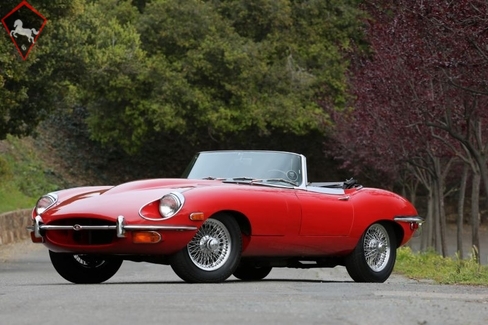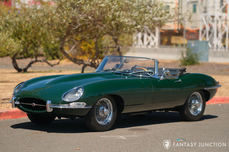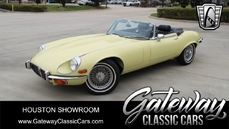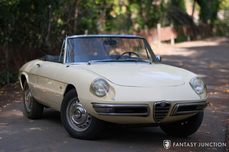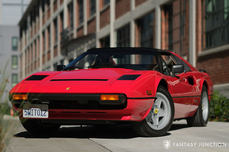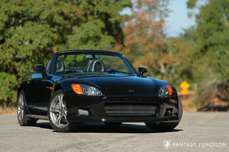Jaguar E-type 4.2 Liter Inline-6 1969
Allgemeine Beschreibung :
1969 Jaguar E-Type Series II
s/n 1R10726, engine no. 7R7273-9
Red with Black Leather
The E-Type was unveiled in March of 1961 at the Geneva Motor Show, following the famous 11th hour disorder (one of the cars was driven to the show from England with just hours to spare). The car was an immediate sensation: its specification was state of the art, its bodywork arrestingly gorgeous, and the price surprisingly affordable. It embodied William Lyons’ values beautifully and it is no surprise that the E-Type has become so iconic. The specification clearly demonstrated Jaguar's racing experience and included independent suspension all around (at a time when Ferrari was still using live rear axles), disc brakes all around (inboard at the rear to reduce unsprung weight), and of course Jaguar's legendary twin cam inline-6. Sales were brisk and the cars were continuously developed.
For the 1969 model year, the Series II arrived, which was substantially the same mechanically as the Series I, but featured a number of safety improvements to satisfy new American legislation. The Series II contained much of the charm of the Series I without the heaviness of the later Series III cars. Series II updates included improved cooling thanks to a larger intake opening, improved lighting, open headlight buckets, and full-width rear bumper.
The first owner purchased this car in Atlanta, Georgia, selling it to the second owner March 15th, 1977. The third owner is then known to have purchased the car June 20th, 1989. He retained the car for more than twenty years, selling it in 2012. During his long-term ownership, the car spent the vast majority of its time in the Metro Atlanta area was restored with attention to detail using quality British parts. The red paint was applied over properly prepared bodywork with selected rust repair limited to the driver’s foot box and the jacking points. On February 19th, 1977 the Georgia State Inspection reported the last known miles on the car at 22,165. Records for the restoration begin October 10th, 1977, but upon completion of the restoration, the odometer was reset to zero in 1987, accounting for the current mileage of 4,677. During the restoration, the head was removed and replaced with a Series III XJ6 head. These later heads have larger valves and breathe better than the earlier heads, which improves performance. Additionally the car was converted to the triple SU carburetor configuration of the Series I cars (US spec Series II cars originally had twin Stromberg carburetors for emissions reasons).
After the restoration was completed, the owner used it sparingly, accounting for most of the currently indicated 4,600 miles, until it was brought to Speedwell garage (in about 2012) for mechanical freshening and sorting as needed. The fuel tank was removed, boiled out, sealed, and the pick up screen and plastic fuel lines were replaced. The intake manifold was removed and the carburetors were rebuilt including new jets and floats. At that time, the cylinder head was also removed and a valve job performed, which included inspecting it for cracks, decking, and fitting hardened valve seats. With the head off, the exhaust was sent out and Jet-Hot ceramic coated while the inlet manifold was reconditioned as well. All fluids were drained and renewed. The distributor was removed and sent to Jeff Schlemmer at Advanced Distributors who rebuilt and re-curved the distributor to allow for matched specifications to the triple carburetor set up. The brakes were flushed as well as the clutch hydraulics. All four ball-joint gaiter boots were replaced and all fittings were lubed and greased including front and rear wheel bearings. Concluding this service work, the car received four new Vredestein 185HR15 Sprint tires and a new battery. Before concluding mechanical systems a few minor electrical issues were tended to as well. All systems in place and ready to go, the compression was checked and all 6 cylinders found to be at 150 psi. The car comes with records back to 1975 and three photo books of documentation, which depict the engine work and other maintenance performed over the years.
Today, this Jaguar presents as an attractive and very honest example which benefits from much restoration work having been done to high standards some years ago, but still presenting as a well maintained and visually pleasant example. The paint is glossy and was nicely done but now shows blemishes from age and use on most panels. The chrome is nicely presented overall but has some hazing in areas, though very much in keeping with the overall presentation. The black vinyl top is sound and in nice condition, appearing to have had only minimal use. The wheels are in very nice condition, still shod with the Vredestein Sprint tires, installed in 2012, approximately 300 miles ago. The lights and glass are in very good condition as well with nice presentation, again in keeping with the quality driver level condition of the car overall.
The interior is in very good shape. The leather seats were reupholstered as part of the restoration thirty years ago and now display a lovely, soft patina. The console and dashboard upholstery are very nice, as are the carpets, all of which were done with high quality materials, which have been afforded thoughtful preservation over time. The steering wheel has the correct appearance and nicely finished aluminum spokes with a handsome and iconic center emblem. The instruments, switches, and controls are in very nice shape as well, once again contributing to the look and feel of an attractive driver level sports car.
The engine compartment is generally very clean and nicely detailed, but not to show standards. The handsome triple SU carburetor setup is a meaningful visual upgrade over the original twin Strombergs, in addition to providing higher performance as well. The engine itself is clean and nicely detailed, while the suspension shows just mild evidence of road use. Overall the engine and engine compartment are nicely finished and properly presented with a few improvements and upgrades to improve the car’s usability. The trunk has been properly finished with a nice tan ambla material, housing a full sized wire wheel and factory specification tool roll. The undercarriage reveals a clean and tidy car that has seen road use but still maintains a very presentable level of detail, with the exception of normal wear on a few painted cast metal surfaces.
One of the added benefits of the later Series II cars is the improved driver ergonomics and their ability to accommodate larger drivers, which contributes greatly to the driving experience. The engine starts easily, runs smoothly on idle and makes excellent power with good oil pressure. The transmission shifts up well through all gears, with good brakes and suspension around town and at highway speeds. The steering, brakes, and suspension all have a very good, harmonious feel, having benefited from proper care and service over the years.
The car comes with several spare parts including the original twin carburetor intake manifold (complete with carbs and air filter mount), an earlier series cylinder head, tool roll, tools, hammer, jack, and knock off spanner. A spare set of pistons and assorted mechanical parts are also included and are assumed to be original to the car. Also included are copious amounts of documents, receipts dating back to 1975, numerous photos of the restoration, an original owner’s manual, service manual, various parts books, and assorted Jaguar specialty literature.
This is an excellent opportunity to acquire a great driving, solid, and honest E-Type Roadster with long-term ownership history. This Jaguar is a strong value compared to the Series I Roadster, particularly given the improved triple-carburetor setup in this roadster. For anyone seeking a fine driving and evocative example of this motoring icon, this is an ideal example to use extensively without fear of ruining a fresh restoration.
http://fantasyjunction.com/cars/2093-Jaguar-E-Type%20Series%20II%20Roadster-4.2%20Liter%20Inline-6
1969 Jaguar E-type 4.2 Liter Inline-6 is listed verkauft on ClassicDigest in Emeryville by Fantasy Junction for Preis nicht verfügbar.
Fakten der Auto
Karosserietyp : Auto Marke : Jaguar Modell : E-type Ausführung : 4.2 Liter Inline-6 Hubraum : 4.2 Modelljahr : 1969 Lage : Emeryville
Verkauft
Angaben Zum Verkäufer
Verkauft
People who viewed this Jaguar E-type also viewed similar Jaguar listed at ClassicDigest
Other cars listed for sale by this dealer
über Jaguar
Ah, die Geschichte von Jaguar, von seinen Anfängen als SS Cars Ltd. bis hin zum Höhepunkt mit dem D-Typ und der Straßenversion des ikonischen E-Typs. An dieser Erzählung haftet etwas zutiefst Britisches, und ich werde sie erzählen, wie es ein britischer Journalist tun würde.Die Anfänge:
Unsere Reise in die Welt von Jaguar beginnt in den 1930er Jahren, als ein Unternehmen namens SS Cars Ltd. auftauchte. Trotz des unglücklichen Zufalls ihrer Initialen, die mit den aufkommenden politischen Spannungen in Europa zusammenfielen, begannen sie, stilvolle und leistungsorientierte Autos herzustellen. Der SS 100, der 1936 eingeführt wurde, war ein Symbol für Eleganz und Geschwindigkeit und legte den Grundstein für das, was Jaguar werden sollte.
Die Geburt von Jaguar:
Als der Schatten des Zweiten Weltkriegs näher rückte, entschied sich SS Cars Ltd. klugerweise, sich von den SS-Initialen zu distanzieren. So wurden sie 1945 offiziell zu Jaguar Cars Ltd., ein Name, der bald für britischen Luxus und Leistung stehen würde.
Die XK-Serie:
Die Nachkriegszeit von Jaguar brachte uns den XK 120, eine wahre Sensation im Jahr 1948. Mit seinem schlanken Design und einem leistungsstarken 3,4-Liter-Sechszylindermotor wurde er zum schnellsten Serienauto der Welt. Der XK 120 war die Blaupause für das, was kommen würde - Jaguars, die Stil mit Geschwindigkeit auf einzigartig britische Weise verbanden.
Die Dominanz des D-Typs:
Dann kam der D-Typ, eine wahre Rennlegende. 1954 eingeführt, gewann er in den 1950er Jahren dreimal Le Mans und zeigte die technische Kompetenz von Jaguar. Mit seiner innovativen Monocoque-Konstruktion und der ikonischen Finne hinten war der D-Typ der Höhepunkt von Jaguars Motorsporterfolgen.
Das Auftauchen des E-Typs:
Aber der wahre Wendepunkt kam 1961 mit der Einführung des E-Typs, oft von Enzo Ferrari als "das schönste Auto, das je gebaut wurde" bezeichnet. Seine lange Motorhaube, die geschwungene Karosserie und ein 3,8-Liter-Motor, der atemberaubende Leistung lieferte, machten ihn sofort zu einem Klassiker. Der E-Typ war nicht nur ein Auto; er war ein Kunstwerk auf Rädern und konnte auf der Straße 150 Meilen pro Stunde erreichen.
Straßen- und Rennsporterfolge:
Die Schönheit des E-Typs wurde durch seine Leistung auf der Rennstrecke unterstrichen. Die leichten E-Typen waren bei verschiedenen Rennveranstaltungen besonders erfolgreich und festigten den Ruf von Jaguar als eine Kraft, mit der man im Motorsport rechnen musste.
Das Zeitalter der Raffinesse:
Je tiefer wir in die Geschichte von Jaguar eintauchen, desto mehr erkennen wir, dass die 1950er und 1960er Jahre ein Zeitalter der Raffinesse und Expansion waren. Neben dem großartigen D-Typ und dem ikonischen Aufstieg des E-Typs führte Jaguar Modelle ein, die seinen Ruf für Luxus und Leistung weiter festigten.
Der MK2:
Ende der 1950er Jahre stellte Jaguar den MK2 vor, eine Sportlimousine, die Eleganz mit Leistung vereinte. Diese elegante viertürige Limousine war sowohl bei Bankräubern als auch bei der Polizei aufgrund ihrer außergewöhnlichen Geschwindigkeit und Handhabung beliebt. Der MK2 war ein Symbol für Jaguars Fähigkeit, Raffinesse mit Leistung zu verbinden und hatte auch eine erfolgreiche Rennkarriere.
Der XJ6:
Springen wir ins Jahr 1968, als Jaguar ein Auto auf den Markt brachte, das Jahrzehnte lang Luxuslimousinen definieren würde - den XJ6. Es war ein Meisterwerk der Ingenieurkunst und des Designs, mit einem sanften Reihensechszylindermotor, unabhängiger Hinterachse und einem geräumigen, wunderschön ausgestatteten Innenraum. Der XJ6 war ein Symbol britischer Eleganz und bot eine so sanfte Fahrt, dass es schien, als würde er förmlich über die Straße gleiten. Er wurde zum Flaggschiffmodell für Jaguar und setzte den Maßstab für Luxuslimousinen und zeigte ein Maß an Raffinesse, das die Konkurrenz staunen ließ.
Die Verschmelzung von Klassik und Moderne:
Während der MK2 und der XJ6 die Evolution der Limousinen von Jaguar repräsentierten, bewahrten sie das Engagement der Marke für Leistung und Luxus. Diese Autos gehörten nicht nur auf die Rennstrecke; sie fühlten sich genauso wohl auf den Prachtstraßen wie auf einer entspannten Fahrt durch die englische Landschaft.
Die Herausforderungen des Wandels:
Dennoch sah sich Jaguar mit dem Eintritt der 1970er Jahre, wie viele britische Automobilhersteller, finanziellen Herausforderungen und Veränderungen in der Eigentümerschaft gegenüber. Die Ära von British Leyland brachte sowohl Chancen als auch Schwierigkeiten mit sich, während die Marke durch verschiedene Fusionen und Übergänge navigierte.
Das Erbe des MK2 und des XJ6, zusammen mit dem D-Typ und dem E-Typ, definiert Jaguar weiterhin als einen Hersteller, der zeitlose Eleganz mit einer Leistungsstärke vereint. Diese klassischen Modelle, ob sie über kurvige Straßen gefahren oder als Sammlerschätze geparkt werden, dienen als Zeugnis für die anhaltende Präsenz von Jaguar in der Welt der automobilen Exzellenz.
Die Jaguar-Geschichte, von ihren Anfängen als SS Cars Ltd. bis zur Schaffung von Automobilikonen wie dem E-Typ, dem MK2 und dem XJ6, ist eine Reise, die das Wesen des britischen Automobilbaus widerspiegelt - eine Mischung aus Luxus, Leistung und Stil, die nach wie vor Enthusiasten und Kenner gleichermaßen fasziniert.
